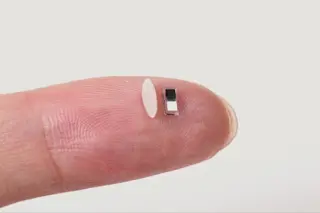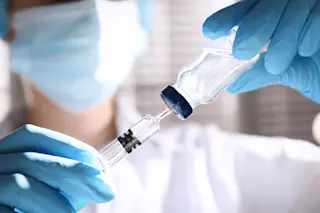The volunteers in Mark Prausnitz's experiment probably didn't believe him when he told them they wouldn't feel a thing. After all, he was proposing to jab 400 tiny needles into their skin. But indeed the subjects reported feeling no pain, even though they weren't anesthetized. Prausnitz, a chemical engineer, and Mark Allen, an electrical engineer, both from the Georgia Institute of Technology, have developed what they believe is a replacement, at least for some uses, for conventional hypodermic needles: a small patch covered with hundreds of microscopic needles that penetrate the skin without causing pain.
The skin's outer layer--the stratum corneum--is an excellent barrier to the outside world, hence the need to poke a large needle through it to get to the bloodstream. But Prausnitz and Allen figured that very small needles could deliver vaccines and medication to the tissue just below the stratum corneum. The medications would then diffuse from the tissue into capillaries. Since the outer skin doesn't contain any nerve endings--the first extensive nerve layer is below the outermost capillaries--the small needles wouldn't cause any pain.
Prausnitz and Allen made their microneedles out of silicon, with the same etching process used to manufacture computer chips. Their 400-needle array is a tenth of an inch on a side, and each needle is just six-thousandths of an inch long. "You feel something, as if you were wearing a Band-Aid," says Prausnitz. "So you're aware that it's there, but it's not at all bothersome or painful."
The holes left by the microneedles are much smaller than the punctures left by conventional needles, thus lowering the risk of infection. And since the patch is so easy to use, it could be a boon for people, like diabetics, who have to give themselves frequent injections.
Prausnitz thinks it wouldn't be too hard to add a microprocessor and a pump, making a watch-size device that could release drugs over time or even monitor blood levels of various medications and automatically keep them stable. "You might actually make it a watch," says Prausnitz. "It would keep track of time and keep track of the amounts that were delivered at different times."














